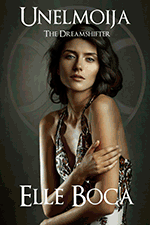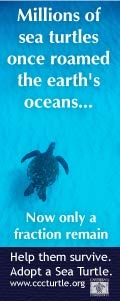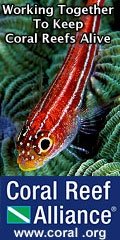Luxury Travel Review

Why we enjoyed Santa Barbara garden
Article and photos by Scott S. Smith
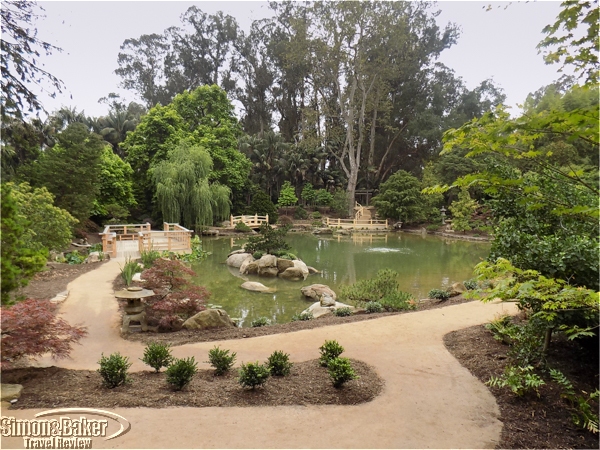
The 37-acres of Lotusland were divided into two dozen areas with a total of more than 30,000 plants.
Although my wife, Sandra Wells and I had no plans to visit Lotusland (695 Ashley Road, Santa Barbara, California 93108, +1 805 969-9990, www.lotusland.org) while we were in Santa Barbara, California we were glad we did. We had more than enough already crammed into the two days we expected to be in the area, located 90 miles north of Los Angeles and known as the Central Coast Wine Country. Perhaps because the city had been featured in the 2004 movie Sideways or because of its pleasant weather and lively arts scene many celebrities have homes there. Let’s just say we were very skeptical when we started and came away converts to the idea that gardens can be fascinating, educational, and fun.
Although the address is on Ashley Road the visitor entrance was at Cold Springs Road and Sycamore Canyon Road. Its long-in-the-making Japanese Garden had just opened two weeks prior to our visit and demand for tickets was backed up. I believe the heavy demand was due to the attraction’s location in a residential neighborhood that capped the number of visitors.
The 37-acres of Lotusland were divided into two dozen areas with a total of more than 30,000 plants, including 3,000 different types of plants, starting with the Australian Gardens at the entrance, which featured, among others, the tea trees from which the well-known healing oil is extracted. Just beyond the gate was the Japanese section (started in 1968, with a final budget of $6 million). It was being finished when we arrived, including the addition of a pagoda as well as the placement of koi and catfish in the pond.
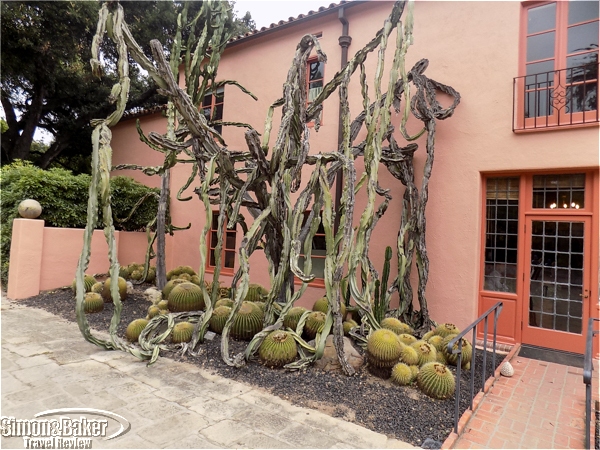
Part of Madame Ganna Walska’s home where the Lotusland offices are now located
Our guide was the well-informed Craig Morgan, whose passion for the beauty and benefits of plants in general and enthusiasm, especially for the garden, sparked our interest. When we later read The Healing Power of Gardens by Oliver Sacks, M.D., in his collected essays, Everything In Its Place, in which the famed observer of the human condition spoke about his experiences using gardens as healing centers we thought of Lotusland.
Then there is the colorful back story. Ralph Stevens bought the property in 1882 for his commercial nursery and home. His widow operated it as a guest ranch, and put it to other uses for 17 years. President Herbert Hoover visited for a garden fundraiser in 1937.
Future owner Ganna Walska was born Hanna Puacz in Brest-Liovsk, Poland, in 1887. At 25, she eloped with a Russian count and seven years later was studying singing in Paris and working under her new stage name. The following year the Russian Orthodox Church dissolved their marriage and Walska moved to New York City to escape World War I. While singing at a theater, she developed a throat ailment that took her to Joseph Fraenkel, M.D. They married 10 days later. In 1918, she made her concert debut on the same bill as legendary tenor Enrico Caruso. At her operatic debut in Havana, Cuba, at the end of the year she met Harold McCormick of International Harvester, a sponsor of the Chicago Opera.
After Fraenkel died, Walska was devastated. When she met rich heir Alexander Cochran on a voyage to Paris they married. Back in New York, she pursued her budding interest in mysticism and seances, as well as a friendship with McCormick, who arranged her debut with the Chicago Opera. A jealous Cochran forced her to cancel her performance. She divorced him in 1922 and married McCormick. He planned a 23-city United States concert tour, but she cancelled the first half when he underwent an appendectomy. He bought her a theater in Paris, which she managed for 10 years and ended up owning for nearly half a century. She made concert tours of America in 1923, 1925, and 1928, the only times during their marriage she visited the United States, despite McCormick’s residence in Chicago. He divorced her in 1931 on the grounds of desertion, but they remained friends. She lived half the year in France, half in New York, where she continued to explore Indian philosophy and her fascination with hypnotism. In 1940, she escaped France on the last commercial passenger ship before the Nazi occupation.
In New York, she studied yoga with Theos Bernard, known as the White Lama. After Walska’s next husband, a physician, died in 1940, Bernard proposed and they decided to buy what was then known as Cuesta Linda, renaming it Tibetanland, with a plan to turn it into a monastery for Tibetan monks. They began planting a variety of gardens and Walska published her autobiography, Always Room at the Top, in 1943. Three years later, they divorced and she never remarried, dedicating her life to collecting rare plants from around the world and creating a unique landscape. She renamed the garden Lotusland because the lotus, which grows in mud but produces a beautiful flower and could be a metaphor for human aspiration, is regarded by many cultures as a symbol of enlightenment and rebirth. She died in 1984. The Ganna Walska Lotusland Foundation spent the next nine years preparing the property for public tours.
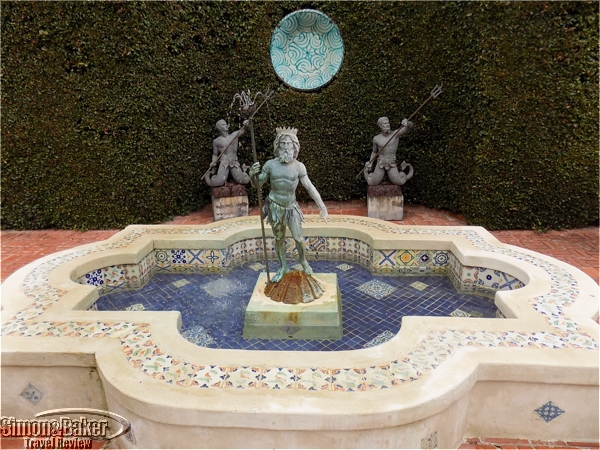
There was art amidst the plants at Lotusland
Lotusland was full of sculptures, such as in the Theatre Garden, which featured a collection of grotesques, 17th century stone figures of an Italian entertainment troupe of dwarves. They were so valued that Walska had them buried with her jewelry when she fled the German occupation. Around some of the pools, like the one in the Aloe Garden (with its 140 species), were giant open clam shells, colorful abalone shells, and turquoise glass (retrieved from the slag at the factory making Sparkletts water bottles). Colored tiles, stones, and sand were used to create pictures and designs by the sides of the paths. There was a Topiary Garden featuring plants growing over wire frames that represented a menagerie, as well as an enormous working clock of flowers. According to Lotusland promotional materials Walska was one of the first garden designers to plant groups en masse to create a dramatic impression.
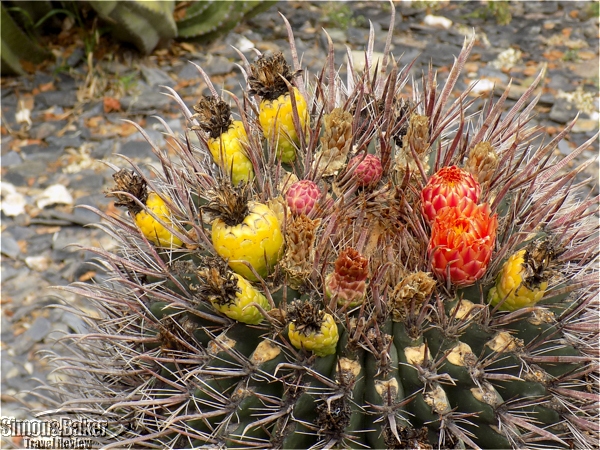
Cactus flowers provided unexpected color
The Cactus Garden contained more than 300 species (one-sixth of the total known), grouped by their country of origin (native to the Americas, they spread to the rest of the world). All have adapted to conserve water, such as thickened parts for storage and the spines, which are its leaves that curb water loss by reducing air flow close to the stem and providing some shade (as well as defense against critters). Unlike other plants, their photosynthesis process, in which carbon dioxide enters the plant and water escapes, cacti delay the latter until night, reducing water loss. A mature saguaro can absorb as much as 200 gallons of water in a single rainstorm. We were amazed at how cacti differed in their shapes, colors, flowers, and the way they twisted to adapt to their neighbors.
It was surprising to come across other species in the Tropical Garden, such as the epiphyllum native to the Brazilian rainforest. We had never thought of cactus being a tropical plant.
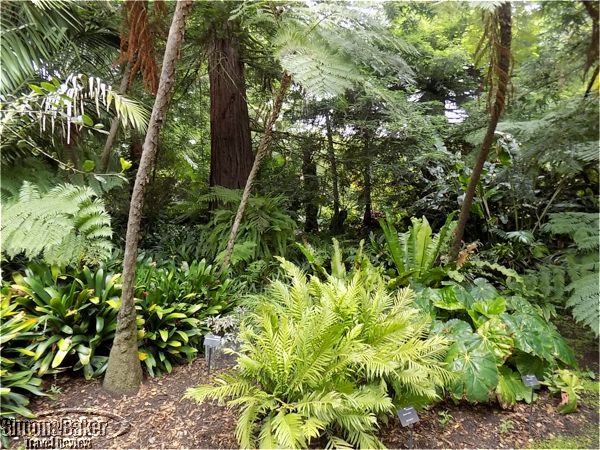
Broad-leafed begonias among the ferns and a mature Dragon Tree, with its umbrella-like branches.
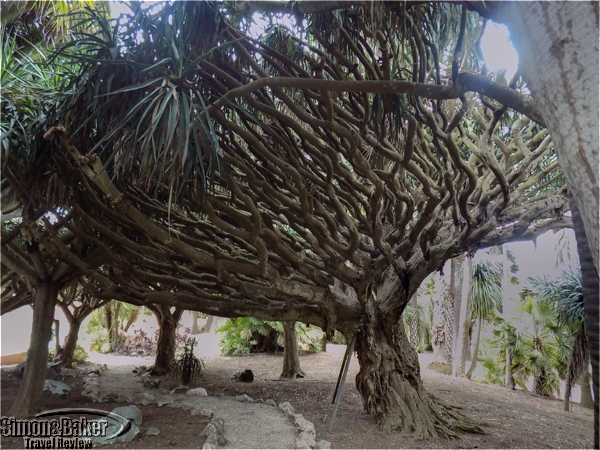
Although we thought of Lotusland as an oasis for desert flora and there were sections for dry-climate trees like palm and olive, it was also lush with a wide variety of plants of other climes.
We thought of Lotusland as an oasis for desert flora and there were sections for dry-climate trees like palm and olive, but it was also lush with a wide variety of plants of other climes. Lotuses and lilies covered a pond in the Water Garden and the Insectary Garden attracted butterflies and insects that have helped gardeners avoid using pesticides. Ferns shared shade with broad-leafed begonias (whose asymmetrical leaves are unique to the plant world in not matching), while other sections were devoted to cypress trees and roses. Mature dragon trees, whose branches reached almost vertically toward the sky, were striking and emitted a red resin known as dragon’s blood, used in folk medicine and favored by Roman gladiators to give them a fierce appearance. Lotusland had one of the most significant collections of bromeliads in the United States, a diverse family whose members trap moisture. They were clustered in several of the gardens, ranging from Spanish moss to pineapple.
One area in transition was the Blue Garden, which Walska had stocked with blue and silver-gray foliage. Tall trees had blocked the sun and the area was being replanted.
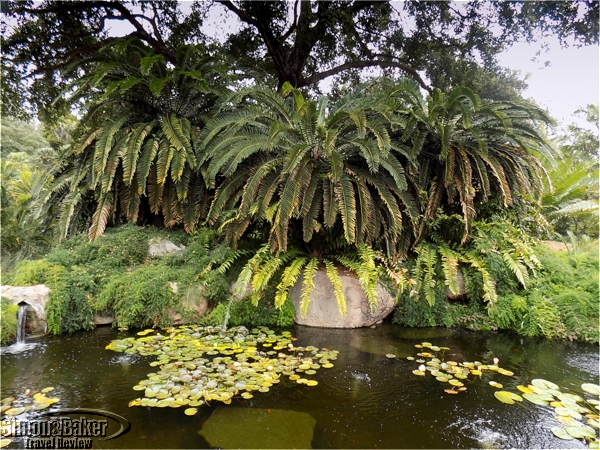
Three of the rarest plants on the planet, giant cycads
The most important section was devoted to the cycads, plants found in the fossil records going back 300 years, whose enormous cone-like reproductive structures called strobili (some weighing 30 pounds) were eaten by dinosaurs. Individual plants are either entirely male or female and may live as long as 1,000 years. They have stout, woody trunks that are often under the ground, while the foliage emerges from the top and grows in a rosette form, so they can look somewhat like ferns or palms. There were 900 specimens in the Cycad Garden.
In 1977, Walska auctioned her jewelry to pay $980,000 for two of the rarest plants in the world, two encyphalartos woodii cycads. Another was added later at an undisclosed price. Five were left in the world, all in private hands and all of one gender. It was believed that there were none left in the wild.
The horticultural wonderland of Lotusland impressed us. We were constantly surprised by the garden’s rare species, the exotic appearance of so many plants, and their beauty (not to mention the interesting story of Madame Walska). We now understand what she meant when she said in her autobiography that she was “the enemy of the average.” We look forward to exploring other gardens across the world.
Fiordland, New Zealand by helicopter
Article and photos by Elena del Valle
We spent a few minutes at the hidden valley of Campbell’s Kingdom (click on photo to expand image)
One of the activities I most remember from a trip to New Zealand this year was a 60-minute Doubtful Sound Gold Star Flight. Although it was originally supposed to be the twice as long Dusky & Doubtful Sound flight poor weather caused it to be severely shortened. To say the flight was bumpy is an understatement. Because of the conditions in the sky everything was gray and wet. Despite that the scenery was magnificent in every direction. From my window side seat I saw oversize natural beauty with no sign of human habitation as far as my eyes could reach. It was one of the highlights of my Intrepid tour in the South Island.
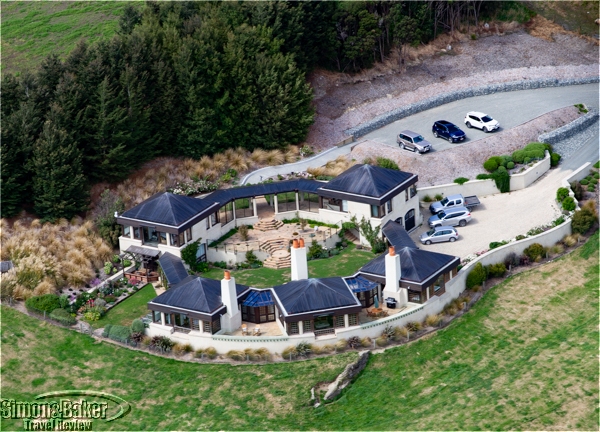
The helicopter picked us up at Cabot Lodge, where I was staying
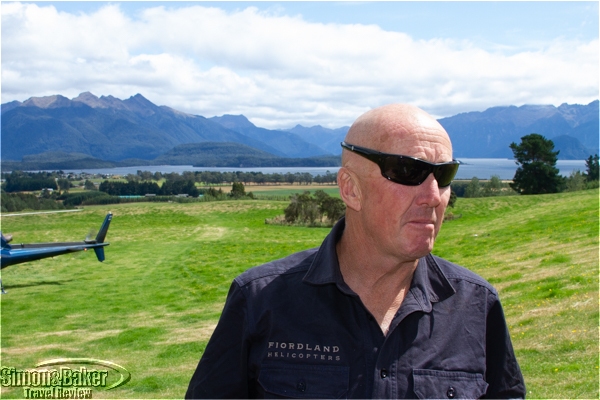
Our pilot Kim Hollows, founder of Fiordland Helicopters
With the arrival of the storm I had become convinced my only chance to see the famed Fiordland National Park would vanish. According to Fiorland.org, the park is over 1.2 million hectares large, and encompasses mountain, lake, fiord and rainforest environments. Due to the remote location and my tight itinerary it wouldn’t have been possible to reschedule the flight. When my guide described the weather the day prior to the flight I crossed my fingers that we might have a chance to see the park. After two or three delays I figured it wouldn’t happen so when the chopper landed on the green lawn of Cabot Lodge, where I was staying, I was elated.
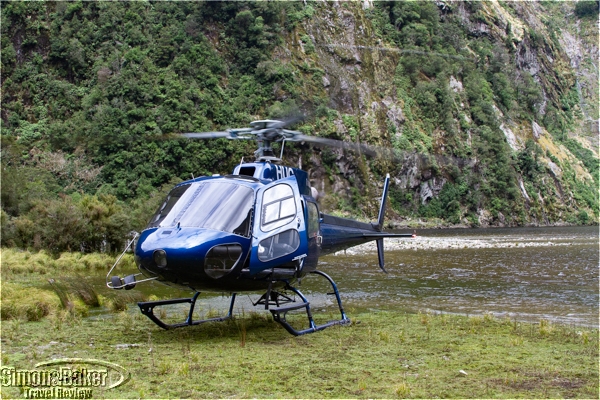
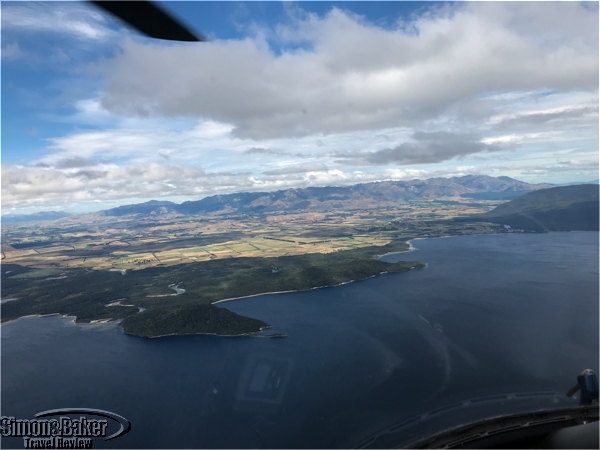
We flew in a late model AS350 B2 Squirrel.
Minutes after Veronika Vermeulen, my guide, and I rushed out to meet Kim Hollows, chief executive officer and founder of Fiordland Helicopters (K.E. Hollows Ltd, 6 Milford Crescent, Te Anau 9600, New Zealand, +64 (0)3 249 7575, www.fiordlandhelicopters.co.nz, info@fiordlandhelicopters.co.nz) we were airborne. Given the turbulence I appreciated that as we departed our pilot said little beyond an initial greeting and boarding instructions. His quiet and energetic demeanor inspired confidence. Kim’s attention was on flying that day. Mine was on the view and taking photos while praying that my stomach would keep it together until we returned.
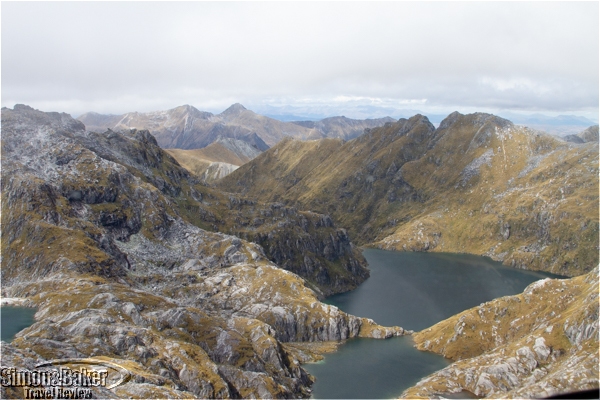
Fiordland National Park
The highlight of the flight were expansive views of Doubtful Sound, the second largest of the fourteen fiords in the park. Since Doubtful is not as popular as it’s sister fiord Milford Sound, the the flight was meant to make visitors feel “like you are alone in the middle of nowhere.” It did. I’m not sure when we crossed the main divide. I remember the tall unnamed waterfall in the hidden valley of Campbell’s Kingdom because it was the only place we landed. We flew in a late model AS350 B2 Squirrel. The company declined to disclose the hours flown or the year of manufacture “due to privacy.” The aircraft could accommodate up to six passengers with a maximum internal weight of 650 kilos.
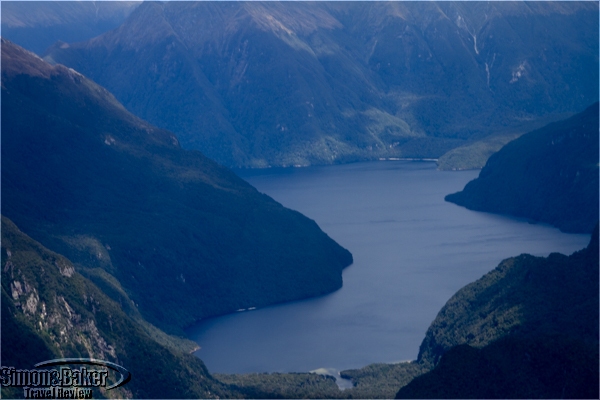
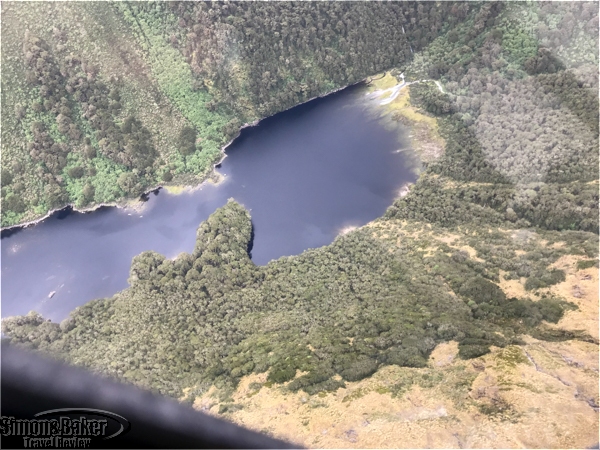
The scenery was awe inspiring.
Kim obtained his commercial pilot’s license in 1980. Although he has flown throughout New Zealand he has spent most of his air time in the lower South Island and Fiordland, according to a staff person at his office who later responded to questions via email. In addition to scenic helicopter flights he has been involved in deer recovery, commercial helicopter operations, filming, photography, and work for the Department of Conservation. He founded K.E. Hollows Ltd, now known as Fiordland Helicopters, in 1986. The spokesperson indicated the company’s safety record was impeccable. Relying on his vast knowledge and passion for the region he made Ata Whenua – Shadowlands, a film that shows daily at the Fiordland Cinema nearby. The owners of Cabot Lodge kindly made it available so the other lodge guests and I could watch it on my return from the flight. The clear weather conditions showcased in the film made me further appreciate the awe inspiring scenery. Should I return to New Zealand I would love to include the Dusky & Doubtful Sound flight in my itinerary. I will recommend it to friends traveling to the South Island.
Our first Hilton stay: the redesigned Resort in Santa Barbara
Article and photos by Scott S. Smith
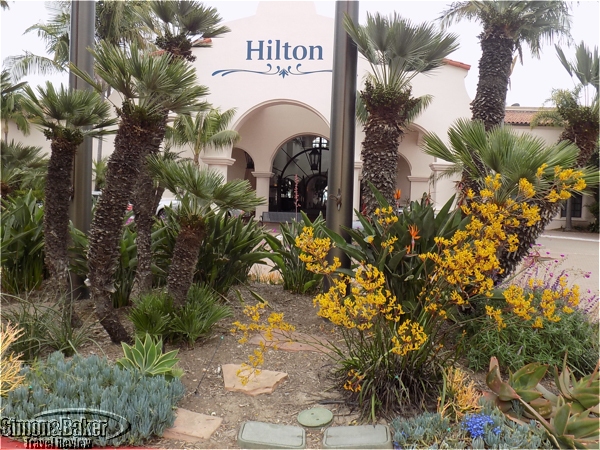
The entrance to the recently remodeled Hilton Santa Barbara Beachfront Resort
The first Hilton my wife, Sandra Wells, and I ever stayed at was the Hilton Santa Barbara Beachfront Resort (633 East Cabrillo Boulevard, Santa Barbara, California 93103, +1 805 – 564-4333, text +1 805 – 465-9770, fax +1 805 – 564-4964, reservations 800/879-2929, https://www.hiltonsantabarbarabeachfrontresort.com/) in June 2019. In 2018, it had undergone a $15 million redesign and renovation. It had previously been a Double Tree, a Hilton brand, part of its 30-year partnership with the family of actor Fess Parker. The location was where a roundhouse for the Southern Pacific Railroad was built in 1911 and demolished in 1982 to make way for the resort, opened in 1986 (hence, the name of the hotel’s breakfast room, The Roundhouse).
The initial view of the hotel was striking: it had three levels and was spread out over 24 acres with large lawns, with a pale exterior and red tile roof, a design inspired from the Spanish heritage of California. Santa Barbarans like their buildings to fit into the environment, rather than being tall monuments to corporate egos that demand the highest possible viewpoint. The hotel was within easy walking distance (about one mile) of Santa Barbara’s quaint downtown.
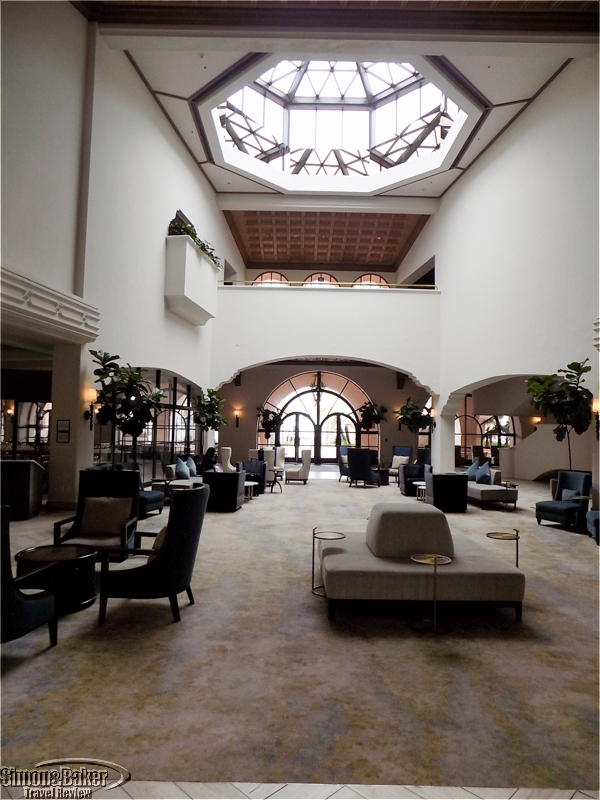
The lobby was open, airy and spacious with white and pastel colors.
Our check-in went smoothly, with well-informed and courteous associates trained, as general manager Chris Inman told us, “to get to know our guests so we can provide exceptional service with sincerity and authenticity.” Because we were two hours early for the hotel’s 4 p.m. check-in time (for an extra charge it was possible to book a room as early as 7 a.m.) we had to wait an hour while the staff completed the cleaning of Room 336. It was a King Bed Resort View Balcony in the Gardenia building connected to the lobby, priced at $335 that particular night. It came with a Daily Resort Charge card listing amenities, such as a two-hour bicycle rental ($30 value), basic Internet access for two (worth $12.95 and premium was available for an extra $15.95). Standard WiFi was ubiquitous throughout the hotel. Our room rate also included two bottles of bottled water in the room (a $7 value). Self-parking cost $25 a day (valet parking was $35). Shuttles provided complimentary transport from the Amtrak station and the Santa Barbara International Airport from 5 a.m. to 9 p.m. There was an electric vehicle charging station.
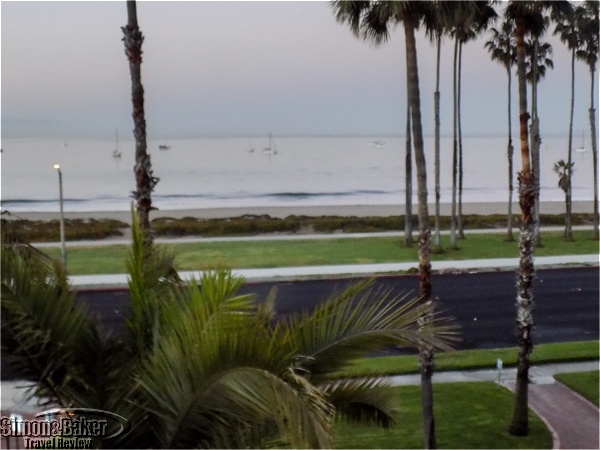
The view of East Beach from the Rotunda outside the lobby
The lobby was open, airy and spacious with white and pastel colors, perhaps an appropriate entry for a destination renowned for its mild climate and sophisticated, artsy culture. The hallway walls and carpets also were in subdued hues of turquoise, gold, gray, white with seascape paintings on the walls of public spaces and our room (the hallway walls were bare). The design was meant to provide a feeling of being in a calming oasis from the turbulence of the outside world, according to promotional materials.
Beyond the far doors of the lobby was the 20,000-square-foot open-air Plaza del Sol, suitable for dining and dancing, with stairs to the second level Rotunda, providing views of East Beach just beyond the lawn and highway (on the other side of the property are the low and lovely Santa Ynez Mountains).
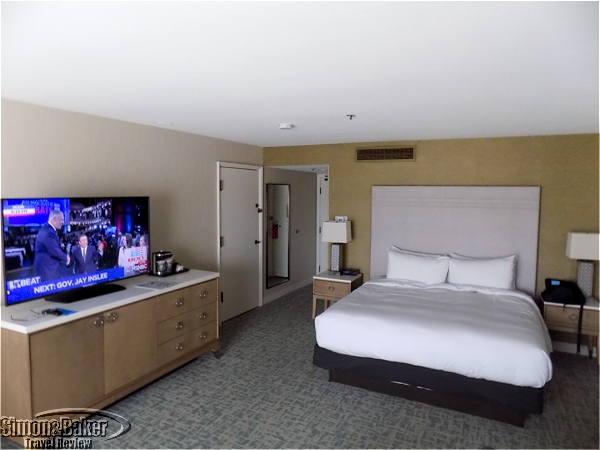
Our spacious (450 square feet) Hilton room
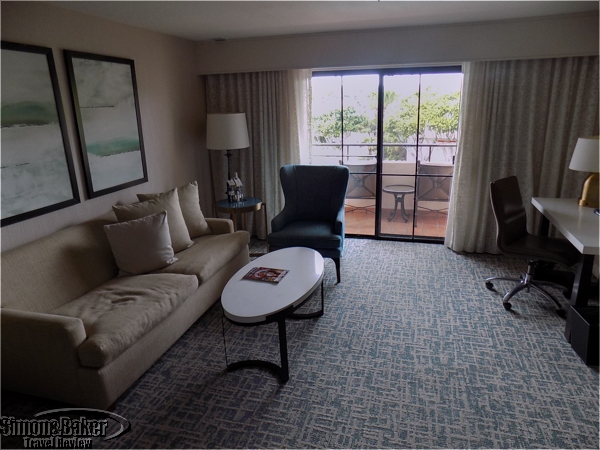
Some of the furniture in our room
In the lobby was the Fess Parker Wine Tasting Room with a self-service wine dispenser. At The Set restaurant there were photos from Parker’s career on the walls. He is best-remembered as the star of Disney’s Davy Crockett mini-series on ABC in 1955-56 (he was discovered by Walt himself and in 1991 was named a Disney Legend); and portraying Daniel Boone in an NBC series 1964-70. He bought hotels and a winery, which now has 1,500 acres of vineyards. His son and daughter run the company. He passed away in 2010. The logo on their bottles is a golden coonskin cap, a reminder of his most famous roles. The winery appeared under another name in the movie Sideways.
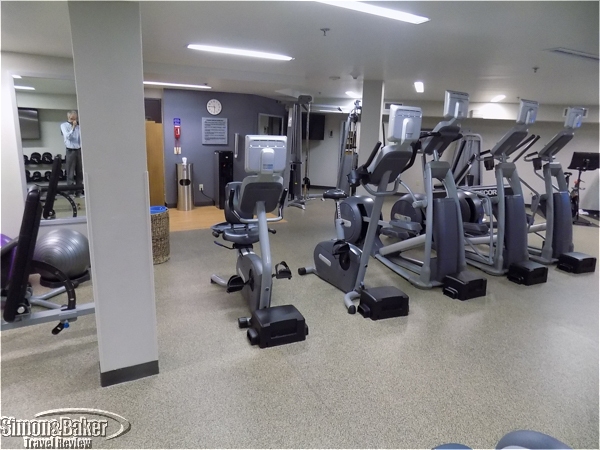
Partial view of the fitness center
The main floor had: business desk with a computer and printer, ATM, car rental desk, concierge, gift shop, fitness center, and salon and spa. The resort was pet-friendly. There was a $50 non-refundable cleaning charge per pet.
Our room was 450 square feet in size with an open design. It had the following security features: an automatic door closer, electronic locks, a secondary locking device, a thumb dead bolt, a wide-angle door viewer, and a hidden safe. We found the king-size mattress and pillows comfortable. We requested that our room not be cleaned during our overnight stay. We dispensed with the turn-down service, and noted the commendable policy that unless otherwise requested, linens were changed every three days to minimize impact on the environment.
Furnishings included beige oversized loveseat sofa bed, armchair, desk with chair, and large chest of drawers. In the closet there was an iron and full-size ironing board. Among the amenities was a landline with speaker phone and voicemail. In addition to the empty mini refrigerator, there was a bucket for the ice machine in the hallway next to the elevator. The flat-screen TV was a 55 inches LG LED with HBO, ESPN, and other premium cable channels. It was easy to use and turned on quickly.
The walls, ceiling, and carpet in our room adhered to the resort’s color scheme of white, beige, tan, gray, and turquoise. We liked that drawing the drapes made the room dark for sound sleeping (we had to cover the lighted clock when we were not using it as a night light). There were copies of USA Today and Santa Barbara Magazine in our room. There was a complimentary welcome tray with nuts, dried fruit, and cheese.
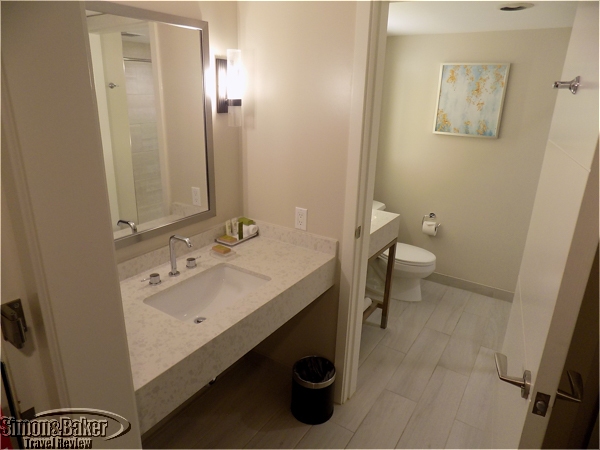

Our bathroom
The sink was deep and wide (9 inches x 14 inches), the water turned hot immediately, and there was plenty of counter space. The toilet flushed strongly. I found the bathroom lighting fine, while some hotels try to be sophisticated by setting it too soft. Sandra felt it was too bright and would have liked to have a magnifying mirror for makeup. The shower was easy to use (unlike some at top hotels that are annoyingly complicated), powerful, and the water came out hot quickly. Sandra would have preferred a wider spray option. The hairdryer was the powerful Conair 1875. The shampoo, conditioner, and soap were Crabtree & Evelyn. We forgot to bring toothbrushes, toothpaste, and a nail file. It would have been helpful to find those amenities in our room.
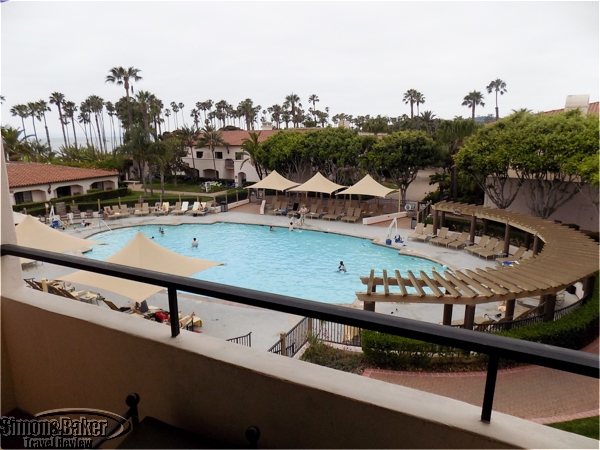
The pool view from our balcony
From our private balcony, furnished with a small round table and two chairs, we had a partial view of East Beach on the Pacific Ocean. The 85 feet by 50 feet swimming pool, was by far the largest we have ever seen at any hotel we have stayed at. The pool was open from 7 a.m. to 11 p.m. We had to delay our normal bedtime to 10 p.m. because the noise from the pool was so loud.
According to promotional materials, the hotel complied with the guidelines of Americans with Disabilities Act in guest and public areas from the restaurants to the fitness center. There was a handicapped lift for those who needed help entering the pool. Our room had a 32 inch clearance width; there were Braille room numbers and closed-captioning on TV; we understood that flashing lights would accompany the sound of fire alarms in public areas.
The Set was a bistro-style restaurant and full bar (featuring Fess Parker photos on the walls), with a patio for al fresco dining overlooking, in the background, the sea, and ever-burning outdoor fire pits. It was open from 11:30 a.m. to 11 p.m., including a Yappy Hour at 4 p.m. when pooches received complimentary dog biscuits (Happy Hour was 5 p.m. to 7 p.m.). The food was locally-sourced and inventive. The restaurant did not accept reservations. Because we were on a tight schedule, we had pre-ordered some menu items. We arrived early and changed our order. Anthony Fanella, director of food and beverage for the resort, ensured our new choices were prepared on time (he answered some of our questions about the hotel in general and introduced us to the Rotunda, which we might have overlooked, the perfect vantage point for a photo of East Beach).
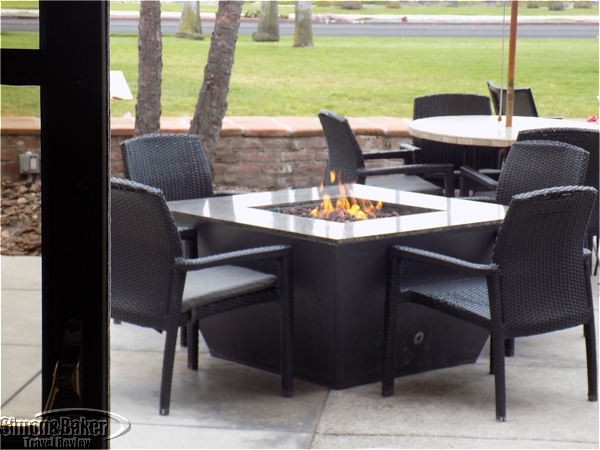
Al fresco dining
We shared a delicious and Tomato Soup au Gratin with aged cheddar ($12). We also tried the Tomato and Peach Salad, with Burrata mozzarella, pickled cherry tomato, arugula, mint, preserved lemon, olive oil, and aged balsamic ($17). I had the Kobe Burger with the plant-based Hungry Planet patty. I found it to be a perfect knock-off of a beef burger ($20). Sandra ordered the Quinoa Fricassee, with toy-box tomatoes, olives, caramelized onions, haricots verts, carrots, cauliflower, preserved lemon, piquillo peppers coulis, and thyme ($19). Our wait-person, Jay, was friendly and helpful. She had only been there a week and came from a popular high-end restaurant. We had a tasty and pleasant meal.
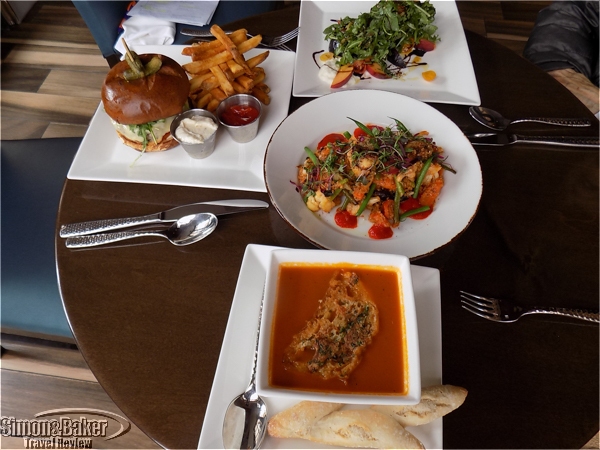
We shared a delicious Tomato Soup au Gratin with aged cheddar.
For breakfast we had the buffet in The Roundhouse ($58 for two plus tax and tip). I liked the Royal Coffee, while Sandra liked the chamomile and green tea blend. She enjoyed a custom-made vegetable-and-cheese omelet. She found the toaster too slow, yet it could suddenly burn, if not watched carefully. I liked the organic granola blend and honey milk, the granola and berry yogurt parfait, plain Greek yogurt with honey, and something I had never tried, overnight oats, which had been soaked in milk. We also sampled some of the ripe fruit and juices.

In the morning we had the buffet in The Roundhouse.
The property was a promising introduction to the new Hilton brand because the location and design were matched to support a relaxing and enjoyable experience with friendly and helpful staff, rather than formal and purely reactive, as at some top hotels. We are eager to try out some of the many other types of properties within the brand and the amenities we did not have an opportunity to experience this time.
Private river safari on New Zealand Waiatoto River
Article and photos by Elena del Valle
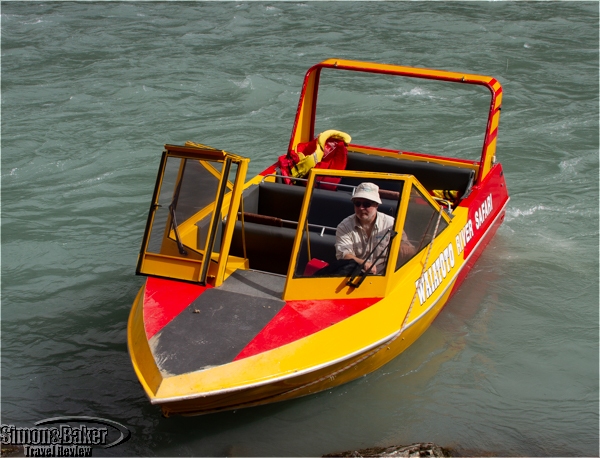
Wayne Allanson aboard our 10-seat KeelowCraft on the 52 kilometer Waiatoto River in New Zealand
I didn’t know quite what to expect during the off the beaten track Waiatoto River Safari in the 355,000 hectare Aspiring National Park, part of the United Nations Educational, Scientific and Cultural Organization (U.N.E.S.C.O.) Te Wāhipounamu World Heritage Park in the South Island of New Zealand. My first clue was Ruth Allanson’s smile when we stopped to check in and sign release forms. It lit up her face and put me at ease. She and Wayne, her husband, owned the company.

Ruth Allanson of Waiatoto River Safari
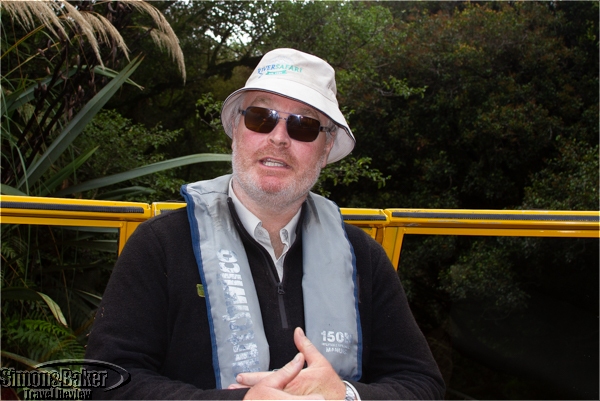
During the tour Wayne stopped in a sheltered corner of the river to tell us about the park.
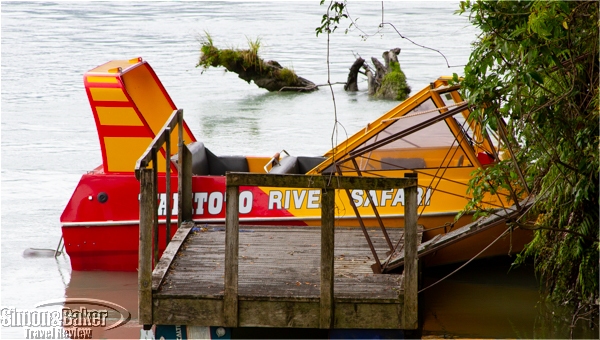
Our departure point
The simple indoor stand housed a desk, promotional brochures and a few local stonework souvenirs. From there a two minute drive led to our departure point, where moments later we met Wayne on the bank of the 52 kilometer Waiatoto River. We were 23 kilometers from Haast and about 200 kilometers from Queenstown.
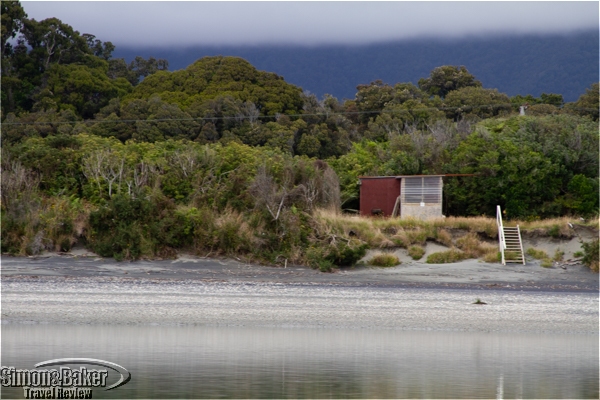
The Waiatoto River, 23 kilometers from Haast and about 200 kilometers from Queenstown
Although it was a clear summer day when we arrived (by the time we returned clouds had descended) there was a chill in the air that promised it would be cooler still on the boat. After applying liberal amounts of insect repellent against the sandflies and donning a loaner coat and I was ready. Veronika Vermeulen, owner of Aroha New Zealand Tours and my guide on an Intrepid tour of the South Island, and I followed Wayne onto a 10-seat KeelowCraft for our two and a half hour private tour. Our boat was 5.7 meters long, 2.2 meters wide, required 125 milliliters of water to operate, and could accommodate up 11 passengers plus driver. It had a Chev 350 V8 petrol engine with a Hamilton 212 jet pump.
The Waiatoto River, part of the U.N.E.S.C.O. Te Wāhipounamu World Heritage Park – click to enlarge
The setting was beautiful. The tour was one of the highlights of my trip to the South Island. The river and lush green vegetation were all around us. After the many crowded attractions we had passed on previous days it was wonderful to be alone on the river. This was in part because the tour was the only way to visit the unspoiled area by land and water. Later Ruth explained by email that the scenery and nature are unique to New Zealand.
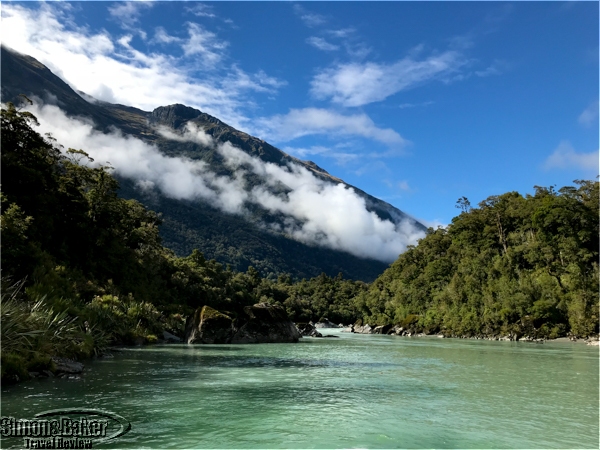
One of my favorite aspects of the tour was that we were the only people visible on the river.
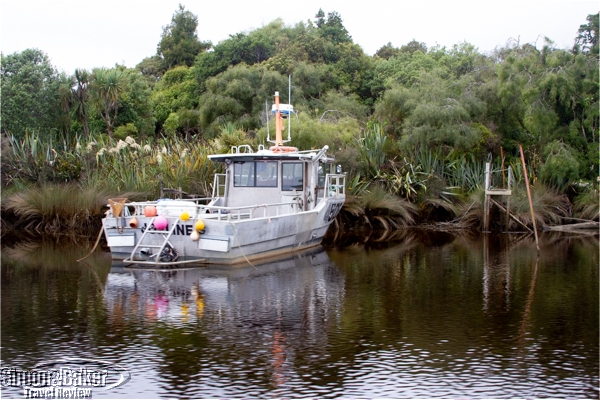
One of few boats we saw although during the whitebait season hundreds of locals descended on the river for their share of the popular fish
The loud engine sounds ensured we focused on the scenery rather than conversation. Wayne slowed down or stopped to show us points of interest, share information and indulge my photo needs. On one of the stops he offered us whitebait snacks. During the whitebait season, hundreds of locals descended on the river for their share of the tiny fish. Although it was past whitebait season Ruth and Wayne had a frozen supply from which they made the snacks.
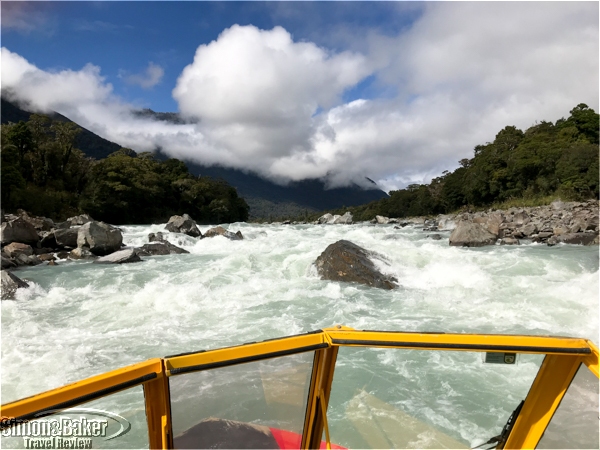
White water on the Waiatoto River
We covered 23 kilometers until the rapids became impossible to navigate. There Wayne tied the boat to the shore. It was easy to step onto land through the front of the boat. Veronika and I gazed at the rushing water, while Wayne secured the boat. Once he joined us we walked 500 meters into the quiet landscape before heading back down the river to the Hindley Stream. By the time we returned to our departure point we had covered 50 kilometers during the tour.
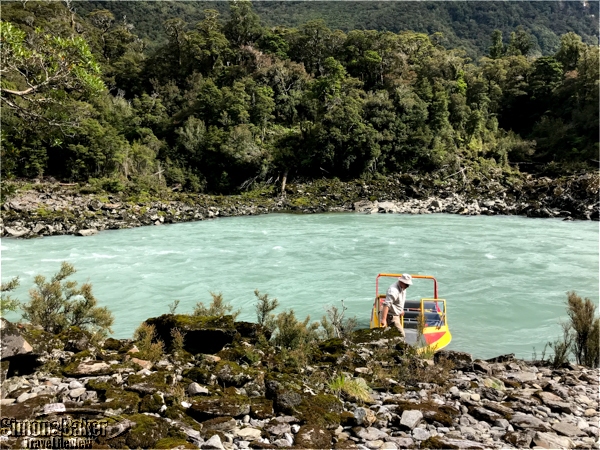
When the river became unmanageable we stopped for a short stroll.
It was nice to know the boats operated with Qualmark Environ motors specially imported for their low fuel use and clean running. I saw no pollution in the water or on land. The Allansons encouraged their clients to “take photos and leave footprints only.”
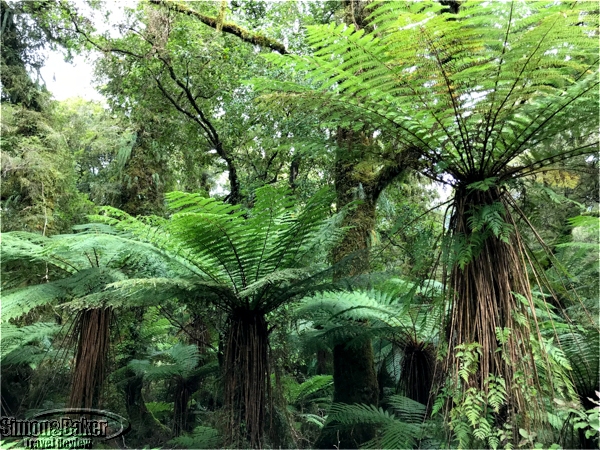
We encountered lush greenery on our short walk.
With advance notice they were able to accommodate some travelers with disabilities. Babies from about 5 months old (provided the life jacket fit) could join their tours and there was no upper age restriction. Life jackets were available up to XXXXL.
At our first stop – click to Enlarge
Once we glided over the river I was glad for the extra loaner layer and the safety of the life vest. Although at one point there were sandflies, perhaps because of the copious quantities of natural repellent I lathered on, they didn’t bother me at all. Waiatoto River Safaris Limited (975 Haast-Jackson Bay road, Hannahs Clearing, Haast, 7844, New Zealand, +64 3 7500 780, www.riversafaris.co.nz, info@riversafaris.co.nz) was owned and operated by a local family since 1997. Theirs was the only company with permission to offer boat tours on Waiatoto River (helicopter companies were allowed enter the park). Ruth and Wayne held Martime New Zealand commercial jet boat licenses, first aid and commercial pilot licenses as well as airplane instructor ratings. They had 12 years of jet boating experience.
According to the U.N.E.S.C.O. website, Te Wāhipounamu World Heritage Park covers 10 percent of the landmass of New Zealand. It has fjords, rocky coasts, towering cliffs, lakes and waterfalls. It was worthy of a detour. I especially enjoyed seeing it by boat.
Why we liked restaurant in off beaten track Paris
By Elena del Valle
Photos by Gary Cox and Elena del Valle
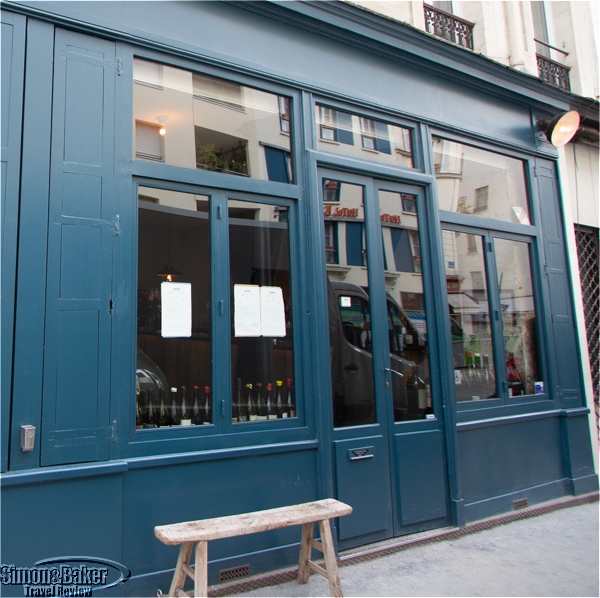
The Septime facade on rue de Charonne in the 11 arrondissement
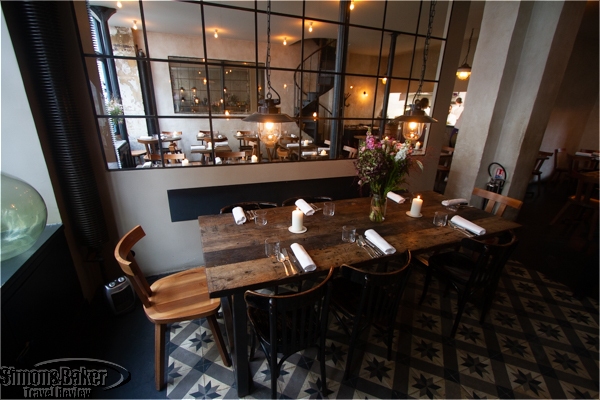
The restaurant was divided into three sections, entrance, main dining area and open kitchen.
Reserving a table at Septime (80, rue de Charonne, 75011 Paris, France, +33 01 43 67 38 29, www.septime-charonne.fr) was an adventurous act because we would only find out the menu at the moment it was served the day of the meal. The emphasis in the kitchen was on seasonal ingredients. Beside that all we knew when we booked our seats was the hour, number of courses and price. And getting there was not so much difficult as out of the well tread tourist circuit, well as much as any neighborhood in Paris, France is out of the tourist circuit.
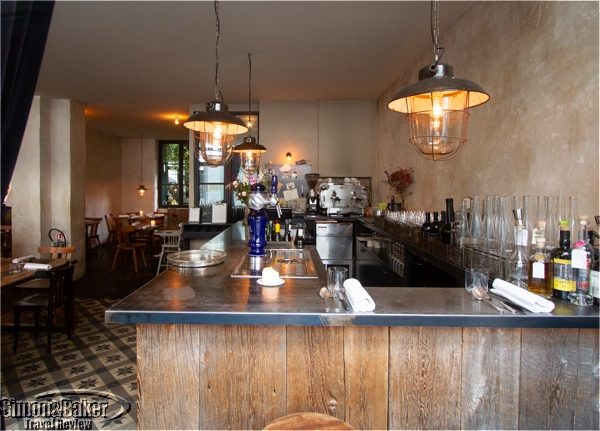
The bar was the first area of the restaurant we saw once we entered.
We liked the young, hip vibe of the unpretentious venue with such an understated facade we almost missed it. Large glass windows allowed passersby a view of the interior, which quickly became crowded. All the tables, even the bar stools, were taken when we were first there. Septime could accommodate a maximum of 38 diners with a staff of 15. The interior of the 62 square meter restaurant was tidy and clean, the young staff welcoming. Glasses, silverware and rolled up cloth napkins sat atop bare wood tables. Lively music filled the air.
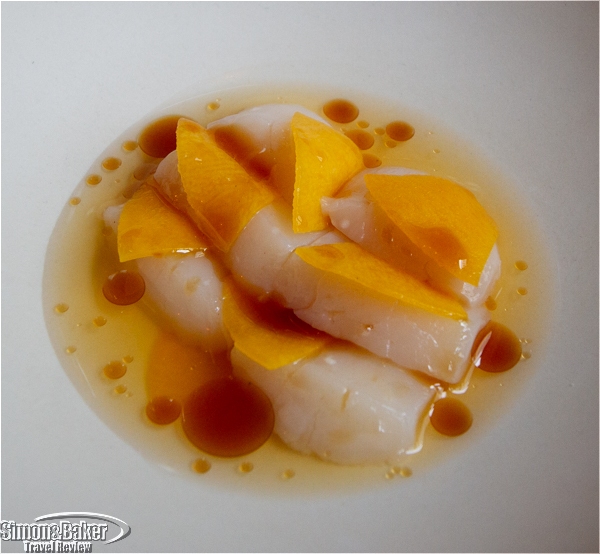
The dishes were visually appealing and well balanced.
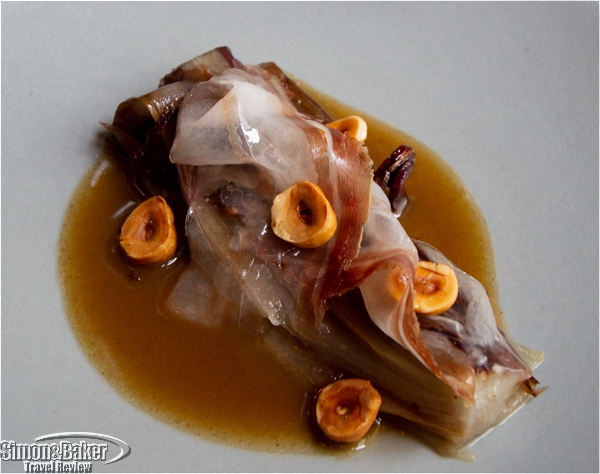
There were two surprise appetizers, two choices for the main course and a surprise dessert.
Natural light filled the dining room. It was toasty warm (we were there in the fall), making it possible to remove jackets and rain gear. The décor was polished and upscale yet urban contemporary. Perhaps because there was a high ceiling it felt spacious although it was full. The tables were close enough to hear neighbor’s conversations without trying. Other features included bare light bulbs, spiral metal staircase (for staff only), unisex bathrooms with a single sink and wood chairs (after a while the lack of cushions made the seats uncomfortable). The dining audience skewed young, diverse and international. An open kitchen allowed us to observe the chefs at work without the cooking smells overwhelming us.
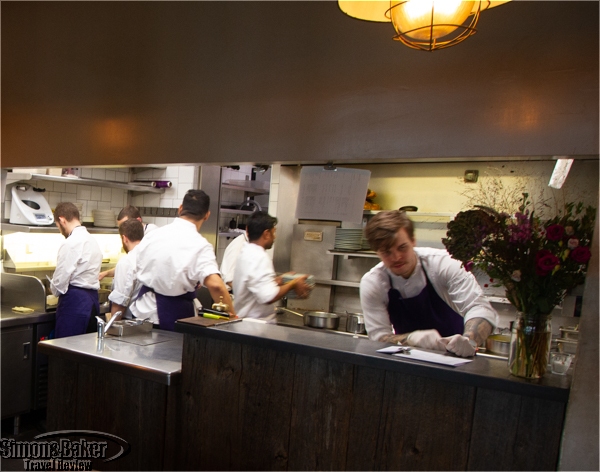
An open kitchen allowed us to observe the chefs at work
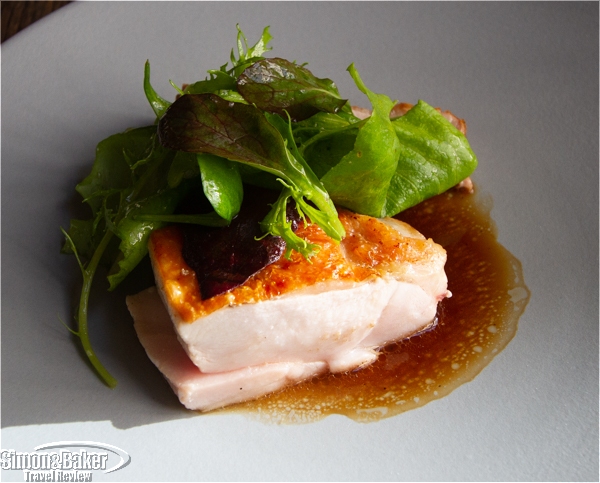
We appreciated that the staff offered a description of the ingredients in English.
The staff were friendly, well informed and helpful. Many were fluent in English, translating the menu and ingredients for us and other diners with ease. And the food? Delicious and outstanding value for money. We paid 42 euros per person per lunch menu, excluding beverages and gratuity.
Our four course menu was satisfying. There were two surprise appetizers, two choices for the main course and a surprise dessert. On our first lunch there was a choice of brill fish in lemon sauce with raw cabbage or young chicken with potatoes in coffee oil, meat juice. We also had raw scallops from Saint Malo, picked squash, squash seeds and black cardamom.
One of the most memorable items was a hodgepodge hot beverage option served in a see through glass container. The bartender made it using whatever fresh fruit was available. Although it was not included in the set menu many of our neighbors ordered it. One infusion was made with apple, yuzu, mandarin orange, thyme and coriander. Another was made with mandarin orange, apple, pear, and verbena and served. The resulting blend of flavors were subtle. On request it was served with honey.
Soon after we sat down our server brought crispy bread sticks with a foamy Gouda cheese dip. There was also crunchy country bread (without butter). Before long someone brought us chilled raw fish with vegetable shavings and celery oil dressing. We appreciated that the staff offered a description of the ingredients in English. The dish had a “clean” refreshing flavor. Warm beets served with black pig from Bigor, smoked lard, Greek Yogurt and mustard seeds was next. Hay infused (who knew you could use hay to infuse flavor?) red sweetbreads served with Paris mushrooms, carrots and shallots in a creamy sauce were next. It was sauteed just right, flavorful yet delicate at once. For dessert there was caramelized ice cream with apple mousseline, quince and fig leaf oil.
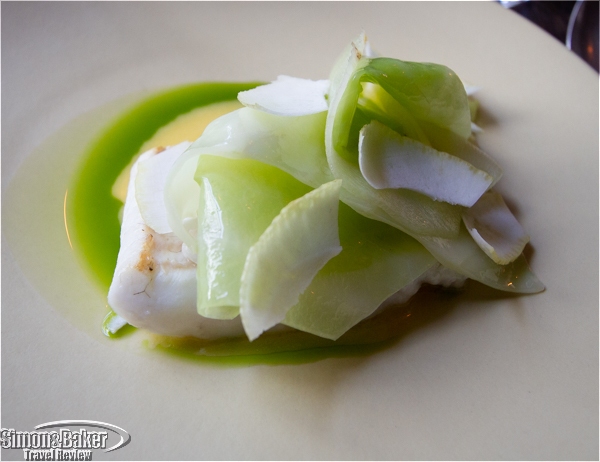
Chilled raw fish with vegetable shaving and celery oil dressing.
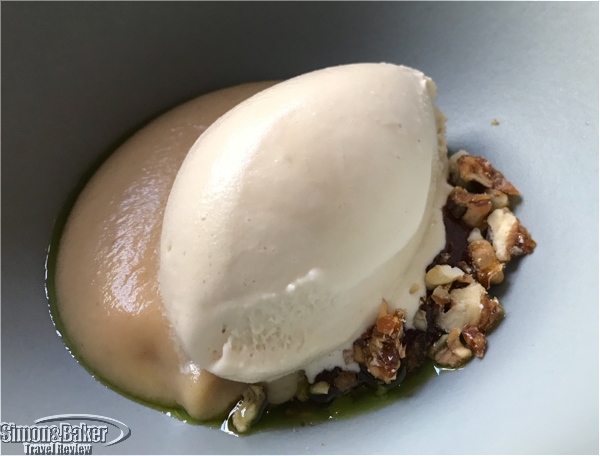
For dessert there was ice cream.
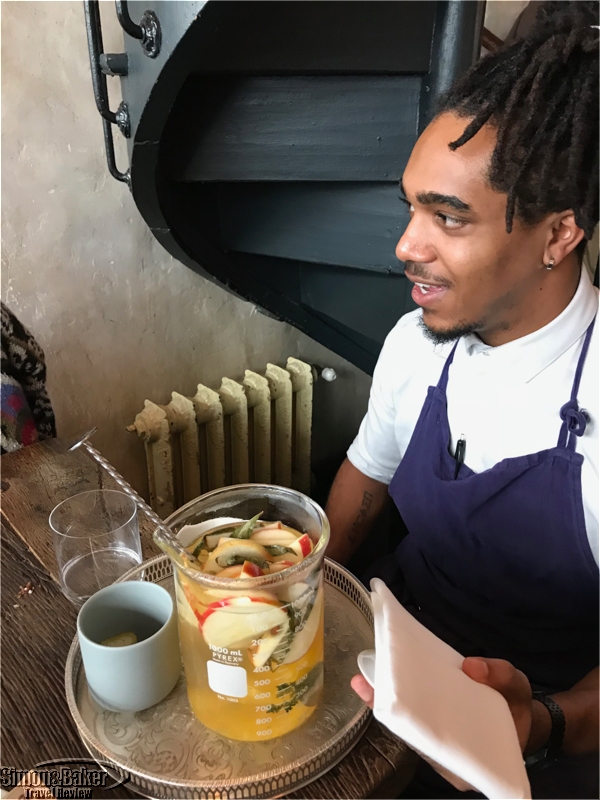
The bartender made a hot beverage with fresh fruit.
The restaurant opened in the spring of 2011 and was named as a tongue-in-cheek homage of the old-fashioned chef from the 1966 movie Le Grand Restaurant starring Louis de Funès. The owners strive to “keep a respectful distance from the all-French ways and means of classical fine dining – while honoring that heritage in our own way,” according to promotional information provided by email by a restaurant representative. “Here at Septime, the sometimes uptight ceremony of “Auteur cuisine” is brought to you with a spirit of lightness.”
The restaurant was owned by Bertrand Grébaut, chef, and Theo Pourriat, sommelier. We later found out that 100 percent of ingredients used in the restaurant were French, organic, and fresh (never frozen). It was noteworthy that 98 percent of the 200 wines on offer were natural, including organic and biodynamic.
South Island bistro offered well prepared lunch, pretty vineyard setting
Article and photos by Elena del Valle
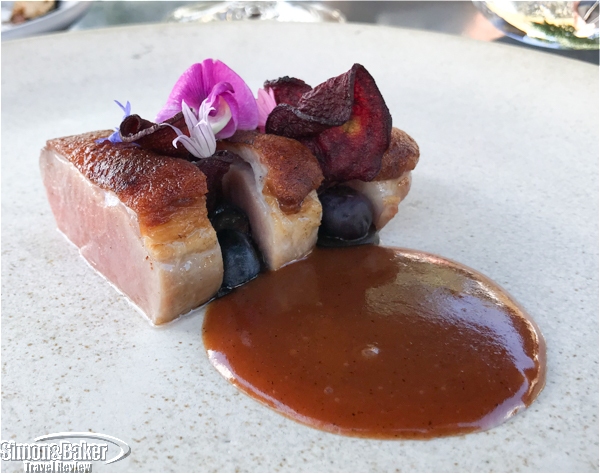
Cardrona Valley lamb neck, garlic yoghurt, pea, umami served with Amisfield Pinot Noir 2016
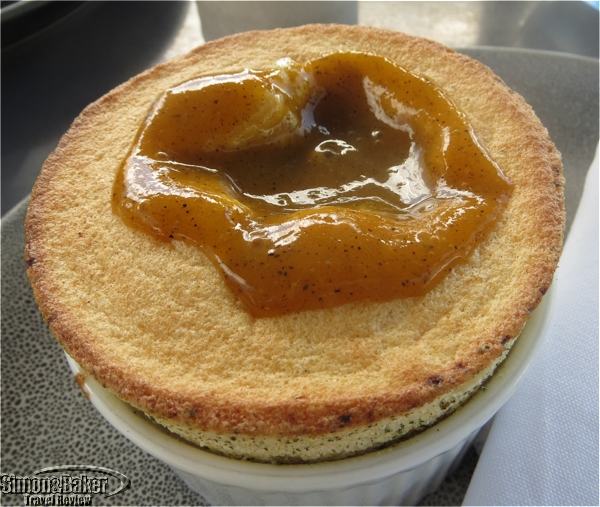
Grilled apricot souffle, lemon verbena
Because I spent most of my trip off the beaten track, on a private Aroha Intrepid tour, my main impression of New Zealand fine dining was derived from lunch at Amisfield Bistro & Cellar Door (10 Lake Hayes Road, RD 1, Queenstown 9371, +64 3 442 0556, amisfield.co.nz, bistro@amisfield.co.nz, cellardoor@amisfield.co.nz), a South Island bistro near Queenstown, where I spent one night. The vineyard side meal was well prepared and well presented, the setting pleasant and pretty. Should I be in the area and in search of a fine dining option I would return, and I would recommend the restaurant to friends and acquaintances traveling to the area.
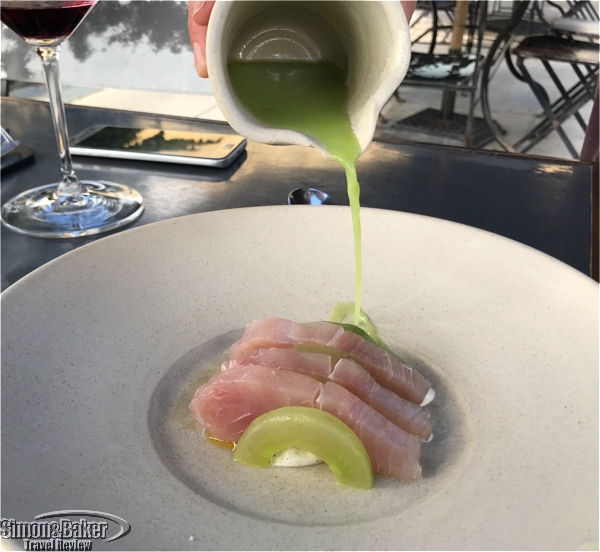
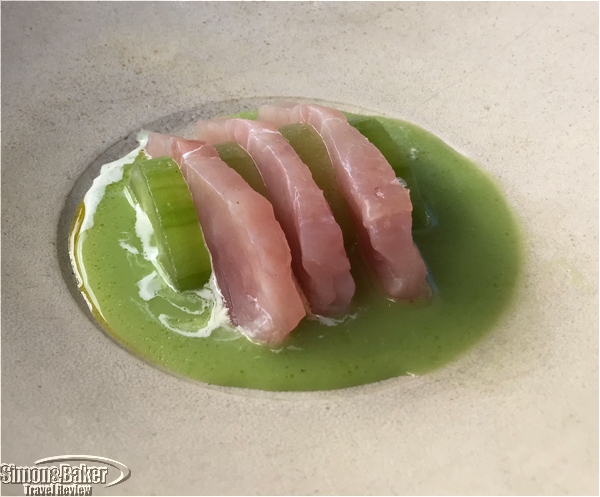
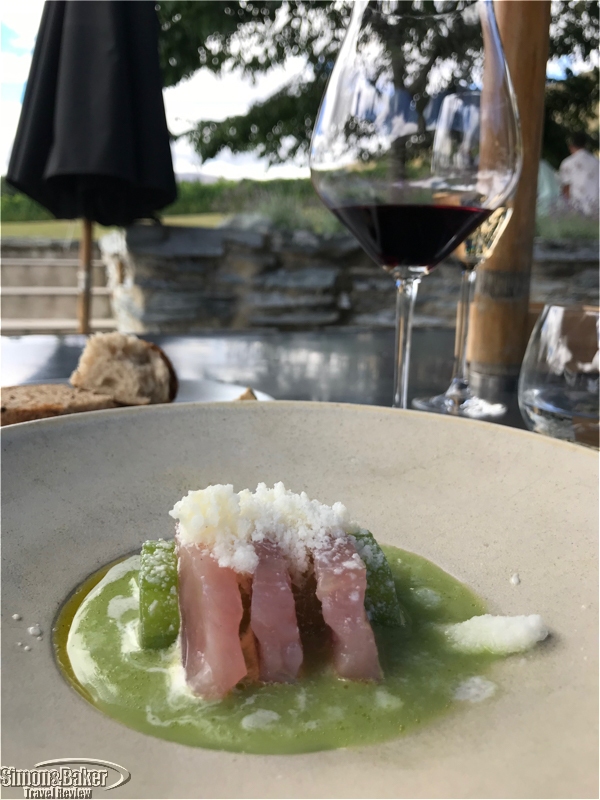
Kingfish, Horseradish, Cucumber
My travel companion and I had lunch there on a breezy and sunny summer day. It was crowded. The restaurant could accommodate up to 100 guests at lunch and 40 at dinner. There were people indoors and outdoors. All the tables I could see from where we sat in the terrace, thankful for the shade of a large umbrella, were occupied. Our table faced a water feature on one side and a green lawn adjacent to the estate vineyards. Despite a mild chill in the air I saw more than one guest take advantage of the respite offered by stacks of sunhats on the edge of the water feature.
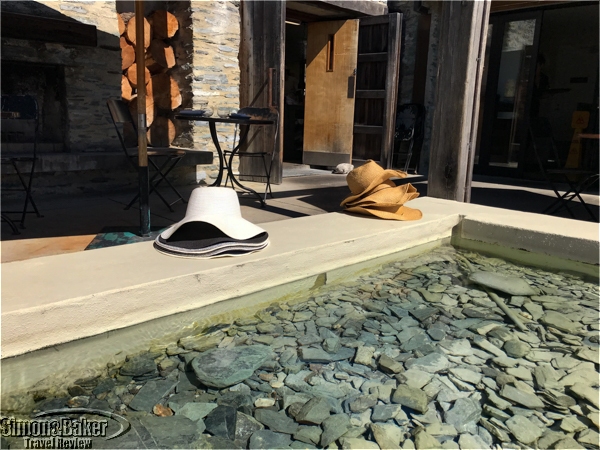
Guests took advantage of the respite offered by sunhats on the edge of the water feature.
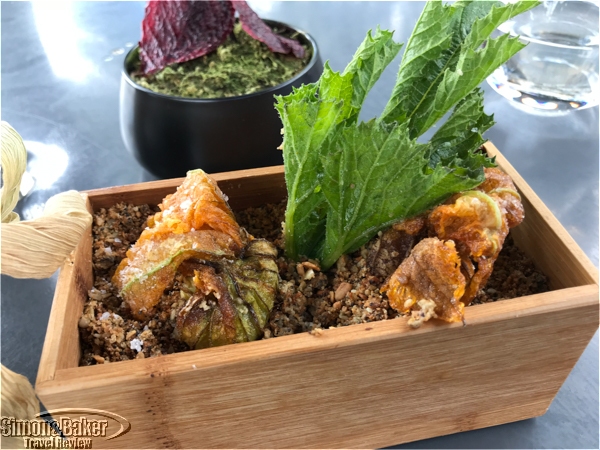
This dish included edible “soil”
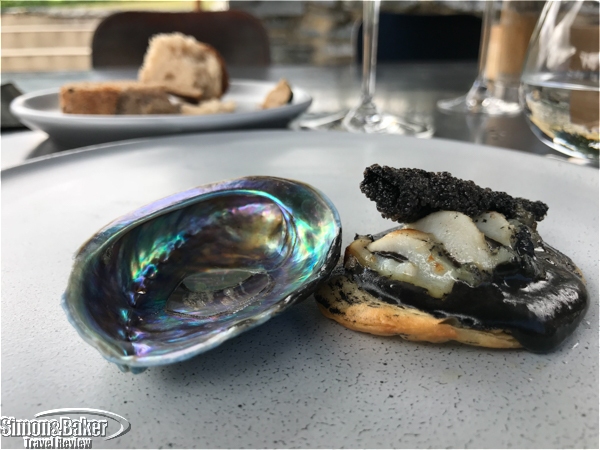
A shellfish delicacy
We both had the 5 Course Trust the Chef tasting menu with a partial wine pairing and a couple of extra bites sent from the kitchen: Zucchini flower Toasted corn; Amisfield Brut 2016, Amisfield breads; Tomato sandwich Amisfield Pinot Gris 2018; The paua pie, Amisfield Fume Blanc 2016; Kingfish, Horseradish, Cucumber, Amisfield Chenin Blanc 2018; Cardrona Valley lamb neck, garlic yoghurt, pea, umami, Amisfield Pinot Noir 2015; Grilled apricot souffle, lemon verbena. Several staff rotated at our table. Whenever a server brought a dish he or she listed the ingredients. Some staff were friendly although service was sluggish. Lunch was inventive, aesthetically oriented and satisfying.
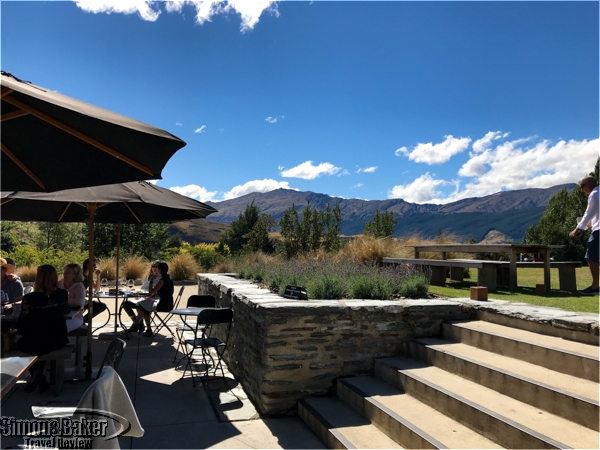
The terrace where we sat for lunch was popular
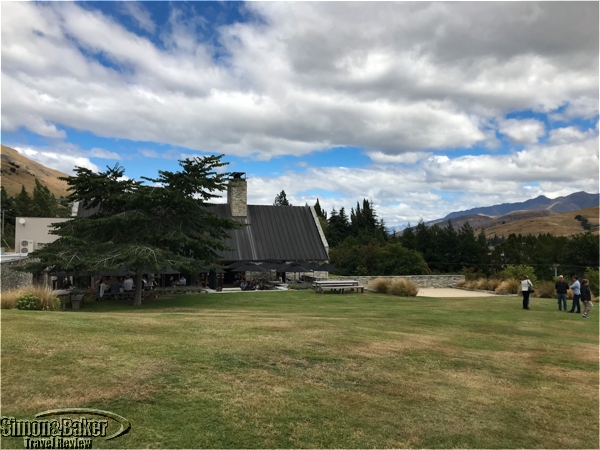
A view of the restaurant built with 1,500 tons of Glenorchy schist and railway sleepers
The two story building was constructed with 1,500 tons of Glenorchy schist and railway sleepers salvaged from a deconstructed bridge in Southland. Headed by Vaughan Mabee, executive chef, the restaurant offered seasonal dishes made from one hundred percent New Zealand ingredients. All meat on offer was grass fed, according to a restaurant spokesperson who responded to questions by email. I liked that the restaurant had an organic produce supplier. The staff only bought sustainable species of fish. Everything was made from fresh, never frozen, ingredients, and the only wines on offer were produced by Amisfield, according to the spokesperson. In 2013, Amisfield began an organic conversion, using as little intervention as possible. The winemaker produced two wines of the natural expression: Amisfield Burn Pinot Gris, an orange wine, and Amisfield Pétillant Naturel.





